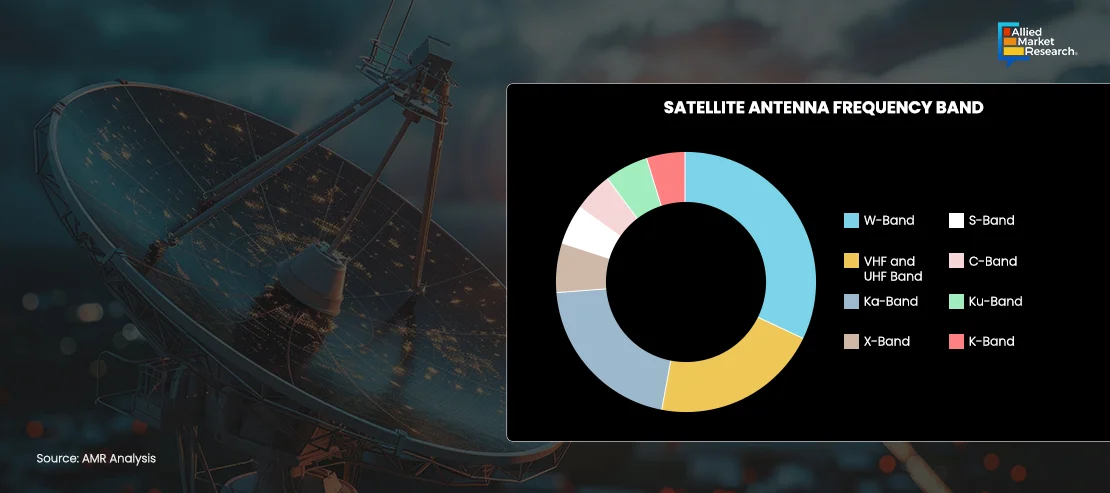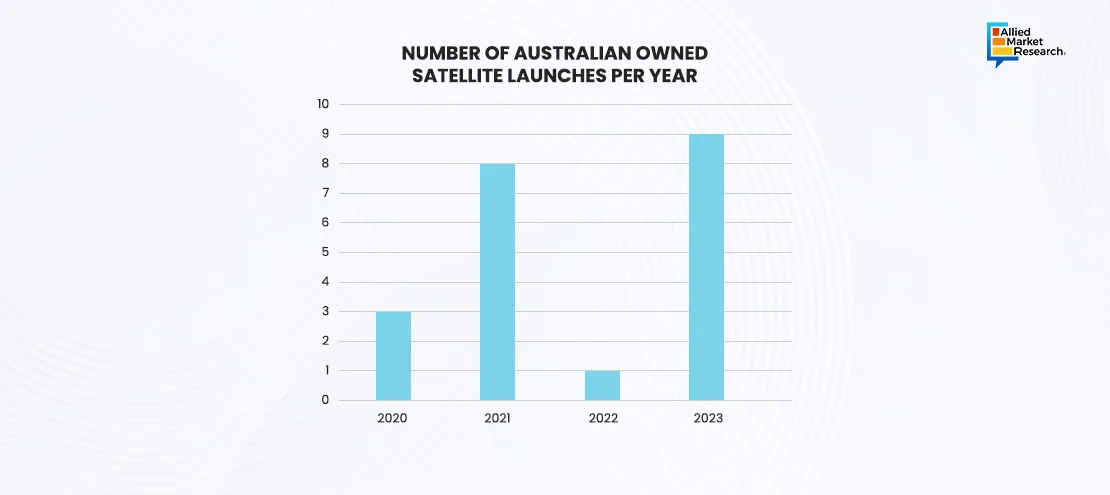Table Of Contents
- Satellite Antennas: The Backbone of Global Connectivity and Innovation
- Transforming Satellite Antennas: Compact Design, Multi-Band Versatility, and AI-Enhanced Performance
- Key Applications of Advanced Satellite Antennas
- Satellite Antennas Powering Global Connectivity
- The Role of Advanced Satellite Antennas in a Growing Industry
- Advancing Antenna Technology
- Final Lines

Lalit Janardhan Katare

Koyel Ghosh
Satellite Antenna Technology: Bridging the Gap in Global Communications

Satellite antennas have undergone significant advancements over the past few decades, driven by the increasing demand for reliable and high-speed communication, broadcasting, and data transfer services. These technological innovations are transforming the landscape of satellite communication, enabling enhanced connectivity and efficiency in various applications, including satellite navigation, internet services, military communications, and television broadcasting. Satellite antennas play an important role in the global communication infrastructure, providing a backbone for a wide range of services. From enabling GPS navigation to facilitating global internet connectivity, satellite antennas are integral to modern communication systems. The continuous evolution of technology has led to the development of more sophisticated and efficient satellite antennas, addressing the growing need for better performance, miniaturization, and adaptability in various environments.
Satellite Antennas: The Backbone of Global Connectivity and Innovation
The need for uninterrupted communication, dependable broadcasting, and quick data transfer is greater than ever. At the heart of this global network lies a prominent piece of technology, i.e., the satellite antenna. These often-unnoticed devices enable us to stream shows and stay connected during important events.
Satellite antennas, essential for transmitting and receiving signals from Earth-orbiting satellites, perform analytic functions beyond television broadcasting. Parabolic dishes, commonly seen in residential areas, focus signals into a central receiver, ensuring a clear and strong connection. However, the role of satellite antennas extends far beyond this. They play a key role in providing internet access to rural and underserved areas, helping to close the digital divide and offer educational and economic opportunities to isolated communities.
In addition to connecting remote locations, satellite antennas support various industries, including agriculture, maritime, and aviation. They enable precise weather forecasting, disaster management, and environmental monitoring by transmitting data from observation satellites. This data aids in early warning systems and improves response times during natural disasters, ultimately saving lives and property. Furthermore, satellite antennas facilitate global communication networks, ensuring that people stay connected regardless of their geographical location. This connectivity is vital for international business operations, telemedicine, and emergency services, highlighting the indispensable role of satellite antennas in modern society.
Operating frequency bands like C-band, Ku-band, and Ka-band are crucial for satellite antennas' performance and versatility. Each band has unique characteristics suited for different uses. By combining multiple frequency bands in antenna arrays, satellite service providers can offer more services and increase revenue.
C-band, identified for its resistance to weather interference, is perfect for broadcasting and long-distance communication, offering dependable service in areas with heavy rain and bad weather conditions. Ku-band, which is used for satellite television and internet services, has more capacity and quicker data rates, making it ideal for direct-to-home (DTH) television and broadband internet access. Satellite antennas can give coverage by using several frequency bands, reaching rural and underserved places. This expansion into new industry generates additional revenue sources from previously unreachable areas due to a lack of infrastructure. Furthermore, satellite antennas' capacity to operate across many frequency bands allows them to offer a wide range of applications in addition to traditional broadcasting. These include connection for marine and aviation, remote sensing, and IoT networks.

Transforming Satellite Antennas: Compact Design, Multi-Band Versatility, and AI-Enhanced Performance
Several technological advancements have significantly contributed to the evolution of satellite antennas, enhancing their performance, efficiency, and versatility. One notable trend is the miniaturization of components, leading to more portable and lightweight antennas. Advances in materials science and manufacturing techniques have enabled the development of compact antennas without compromising performance, benefiting applications like UAVs, handheld satellite communication devices, and portable satellite internet terminals. Modern satellite antennas also incorporate advanced signal processing techniques such as digital beamforming, adaptive filtering, and interference mitigation, which improve performance and reliability by handling weak signals better, reducing noise and interference, and using available bandwidth more efficiently.
Additionally, the ability to operate across multiple frequency bands and support multiple beams simultaneously has become a significant advancement. Multi-band antennas can switch between different frequency bands, allowing greater flexibility and compatibility with various satellite systems, while multi-beam antennas can generate multiple beams to cover different areas simultaneously, which is particularly valuable for satellite internet applications. Furthermore, the integration of satellite antennas with the Internet of Things and 5G networks is a booming area of development. Advanced satellite antennas capable of supporting IoT and 5G connectivity are being developed to facilitate seamless communication between devices, ensuring continuous connectivity and data transfer, driving the growth of smart cities, autonomous vehicles, and other IoT applications.
Lastly, artificial intelligence and machine learning are playing an increasingly important role in satellite antenna technology. AI and ML algorithms can optimize antenna performance by dynamically adjusting parameters based on real-time data, enhancing beam steering accuracy, predicting signal degradation due to weather conditions, and optimizing frequency allocation to minimize interference, thus improving overall system efficiency, reliability, and adaptability.
Key Applications of Advanced Satellite Antennas
Advancements in satellite antenna technology have created new possibilities and applications across various industries. Satellite internet services are becoming increasingly important, with companies like SpaceX's Starlink, OneWeb, and Amazon's Project Kuiper launching many low Earth orbit (LEO) satellites to offer global internet coverage. Advanced phased array and flat panel antennas enable high-speed, low-latency internet access for users worldwide, including those in remote and underserved regions. In the military and defense sector, satellite antennas play a critical role in secure communication, surveillance, and reconnaissance. Advanced phased array antennas offer the flexibility and rapid beam steering capabilities needed for dynamic battlefield environments, ensuring reliable and secure communication in critical operations. In the aviation and maritime industries, satellite antennas provide in-flight and at-sea connectivity, with flat panel antennas being ideal for installation on aircraft and ships. These antennas enable passengers to access high-speed internet, stream media, and stay connected during their journeys, while also supporting navigation, weather monitoring, and emergency communication.

Satellite antennas are also important for disaster recovery and emergency services because they provide communication when other networks are down. Portable and quickly deployable satellite antennas establish communication links in disaster-stricken areas, ensuring connectivity for first responders and coordinating relief efforts. Lastly, in remote sensing and Earth observation, satellite antennas collect and transmit data from orbiting satellites. High-gain parabolic antennas and advanced signal processing capabilities enhance the quality and resolution of remote sensing data, supporting environmental monitoring, agriculture, and climate research.
Satellite Antennas Powering Global Connectivity
The satellite antenna industry is expected to develop significantly as expenditures in space technology increase and the need for robust communication infrastructure rises. The scope of this industry has expanded to cover new areas including autonomous cars, the Internet of Things, and smart cities, all of which require dependable, always-on connection. To address this growing need, companies are producing more sophisticated, cost-effective, and energy-efficient antennas, with the potential to revolutionize global connections.
As governments and companies are investing more in satellite projects, using modern satellite antennas has become important for ensuring smooth and effective communication. The competitive landscape is also becoming more intense, as new and existing companies work hard to innovate and capture market share. This competition is driving big advances in antenna technology, making them better and smaller. Satellite antennas are now more versatile and can help in areas like disaster recovery and rural internet. They will be crucial for future global communication.
The Role of Advanced Satellite Antennas in a Growing Industry
The satellite antenna industry is fueled by ongoing technical breakthroughs. Modern antennas are getting more compact and efficient, with flat panel and phased array designs providing outstanding performance in a tiny form factor. These advancements are especially beneficial for transportable applications aboard ships, planes, and vehicles, where space and weight are limited. The advent of low Earth orbit (LEO) satellite constellations, such as SpaceX's Starlink and Amazon's Project Kuiper, is driving up demand for improved satellite antennas capable of tracking many satellites and managing high data flow. Hybrid antennas capable of switching between satellite and terrestrial networks have evolved. This flexibility provided ongoing connection by using the strengths of both networks. Advanced material research, such as metamaterials and graphene, has resulted in the development of lighter, more durable satellite antennas. These materials increased performance while lowering weight and cost.
Australia has launched a total of 49 satellites, with the accompanying graph illustrating the number of launches of Australian-owned satellites in the years they took place. On average, 2.2 satellites were launched per year during the years when launches occurred. As many satellites are deployed, the demand for advanced and reliable satellite antennas rises, driven by the need to establish robust communication links with these new satellites. This demand fuels innovation and development in the satellite antenna industry, leading to the creation of more sophisticated and versatile antenna systems.
Advancing Antenna Technology
In March 2023, the federal budget of Canada allocated USD 2.5 billion to boost its space leadership, including USD 150 million over five years dedicated to the Lunar Exploration Accelerator Programme (LEAP). This investment aims to propel Canada's space industry and accelerate technological advancements. On a global scale, the satellite industry witnessed significant growth, with the Union of Concerned Scientists reporting that, as of April 30, 2022, the United States operated 3,433 functioning artificial satellites—far surpassing China's 541. Jonathan's Space Report further highlighted that by 2022, there were 6,905 operational satellites orbiting Earth, marking a substantial increase of 2,105 from the previous year, signaling potential industry growth.

In April 2023, Kratos Defense & Security Solutions, Inc. launched the OpenEdge 2500 digitizer, advancing technology in defense and communications. In June 2023, Oerlikon AM and Airbus agreed to a €3.8 million deal to 3D print satellite antenna clusters from aluminum using laser technology for communication satellites. Additionally, Kymeta partnered with OneWeb to introduce the Peregrine u8 LEO terminal, the first flat panel antenna designed for the maritime industry on OneWeb's LEO network. That same month, Intellian Technologies opened a new Advanced Development Center (ADC) in Maryland, USA, to serve as a primary hub for designing and engineering flat panel antennas and terminals. This expansion reflects the rising demand for phased array antennas from enterprise, government, and maritime sectors, highlighting a growth opportunity for Intellian.
Final Lines
The satellite antenna industry is growing quickly due to advances in technology, the need for high-speed internet in remote areas, and more use of smart devices. New satellite constellations, especially low Earth orbit (LEO) satellites, are improving connectivity by reducing delays and increasing bandwidth. This is important for things like telemedicine, remote education, and emergency response. AI and machine learning are making antennas smarter and network management more efficient. With more investments in space infrastructure from both governments and private companies, the industry is expected to be a major part of global communication networks, shaping how we connect and interact in the future.
Allied Market Research aims to equip stakeholders with comprehensive knowledge about the Satellite Antenna Technology within the aerospace industry. By understanding this practice, vendors can strategically position themselves to make the most of its benefits. We encourage vendors to explore opportunities for integrating satellite antenna technology into their business processes, utilizing its capabilities to enhance efficiency, mitigate risks, and ultimately drive success in an evolving marketplace. Embracing this innovative approach is expected to not only optimize operations but also foster growth and competitive advantage in the dynamic landscape of aerospace and defense. For more insights into satellite antenna technology, contact our specialists today!

